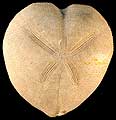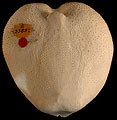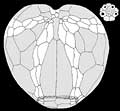This is one of the best known of all Cretaceous echinoids and has formed the basis for classic microevolutionary studies. Stokes (1975), Ernst (1970, 1972), Maczynska (1968) and Fouray (1981) deal in depth with the taxonomy of many of the Cretaceous species. Nichols (1959) made a classic analysis of the mode of life of Micraster.
Micraster differs from Gibbaster in having pores in the frontal ambulacrum that are differentiated (non-petaloid) and presumably associated with funnel-building tube-feet. Isaster and Cyclaster have an apical disc with three gonopores, whereas Micraster always has four. Mokotibaster differs in having almost no posterior truncate face and the periproct is subambital. Pseudogibbaster is more inflated and has a peristome that faces downwards, not forwards.
Stokes, R.B. 1975 Royaumes et provinces fauniques du Cretace etablis sur la base d\'une etude systematique du genre Micraster. Memoires du Museum National d\'Histoire Naturelle, nouvelle serie C 31, 1-94, pls 1-12.
Ernst, G. 1970. Zur Stammesgeschichte und stratigraphischen Bedeutung der Echiniden-Gattung Micraster in der nordwestdeutschen Oberkreide. Mitteilungen aus dem Geologisch-Palaontologischen Institut der Universitat Hamburg 39, 117-135.
Ernst, G. 1972. Grundfragen der Stammesgeschichte bei irregularen Echiniden der nordwesteuropaischen Oberkreide. Geologisches Jahrbuch (A) 4, 63-175.
Fouray, M. 1981. L\'evolution des Micraster (Echinides; Spatangoides) dans le Touronien-Coniacien de Picardie Occidentale (Somme), interet biostratigraphique. Annales de Paleontologie, Invertebres 67, 81-134.
Maczynska, S. S. 1968. Echinoids of the genus Micraster L. Agassiz from the Upper Cretaceous of the Cracow-Miechow area. Prace Muzeum Ziemi 12, 87-168, pls 1-28.
Nichols, D. 1959. Changes in the chalk heart-urchin Micraster interpreted in relation to living forms. Philosophical Transactions of the Royal Society, London B 242, 347-437.




